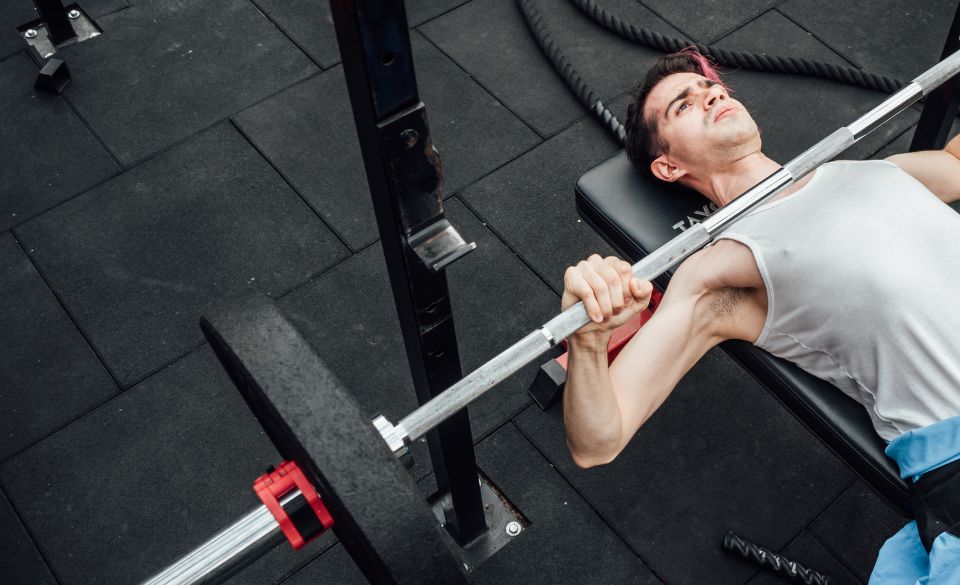
The Ultimate Guide to the Larsen Bench Press
Page Contents
If you’re looking for a new way to spice up your weightlifting routine, look no further than the Larsen bench press. This unique variation of the traditional bench press offers a challenging and effective workout that can help you build strength and muscle in your upper body. In this article, we’ll explore what a Larsen bench press is, how to perform the exercise, and the benefits of incorporating it into your fitness routine.
What Is A Larsen Bench Press?
A Larsen bench press is a variation of the traditional bench press that involves performing the exercise on a specially designed bench with a split pad. The split pad allows one arm to be raised higher than the other, creating an asymmetrical load on the body. This asymmetrical load forces the muscles on one side of the body to work harder than the other, resulting in a more challenging and effective workout.
How To Perform The Exercise
Performing the Larsen bench press is a challenging but rewarding exercise that can help you build strength and muscle in your upper body. Here’s a step-by-step guide on how to perform the exercise properly:
1. Set up the bench: The Larsen bench press requires a specially designed bench with a split pad. Make sure to adjust the bench so that one arm is raised higher than the other.
2. Get in position: Lie down on the bench with your feet flat on the ground and your back flat against the bench. Grip the barbell with one hand in a normal position and the other hand in a close grip position.
3. Lower the bar: Lower the barbell to your chest slowly and with control, making sure to keep your body stable and balanced despite the asymmetrical load.
4. Press the bar: Push the barbell back up to the starting position, again focusing on maintaining stability and balance despite the asymmetrical load.
5. Repeat: Perform the exercise for the desired number of reps and sets, making sure to switch the position of your hands to work both sides of your body equally.
It’s important to note that proper form and technique are crucial for avoiding injury and getting the most out of this exercise. Make sure to keep your elbows close to your body, engage your core muscles to maintain stability, and avoid arching your back or using momentum to lift the bar.
How Much Harder Is A Larsen Press?
The Larsen bench press, also known as the Viking press or the offset barbell press, is a challenging exercise that requires one arm to lift a heavier weight than the other. This creates an asymmetrical load on the body, which has been shown to increase muscle activation and overall strength.
One study published in the Journal of Strength and Conditioning Research compared muscle activation in the chest, triceps, and biceps during a standard bench press and a Larsen bench press. The results showed significantly greater activation in the chest, triceps, and biceps on the side of the body lifting the heavier weight in the Larsen bench press compared to the standard bench press. This suggests that the Larsen bench press is a more effective exercise for targeting these muscle groups.
Another study published in the International Journal of Exercise Science compared the muscle activation and strength gains of the Larsen bench press to the standard bench press in a group of experienced lifters. The results showed that the Larsen bench press led to greater muscle activation in the chest, triceps, and biceps, as well as significantly greater strength gains compared to the standard bench press.
Overall, the Larsen bench press is a challenging but highly effective exercise for building upper body strength and muscle. Its unique asymmetrical load creates greater muscle activation and can lead to greater strength gains compared to traditional bench pressing exercises. Incorporating the Larsen bench press into your weightlifting routine can help you break through plateaus and achieve new levels of strength and muscle development.
Benefits Of Doing A Larsen Bench Press?
In addition to the increased muscle activation and strength gains, the Larsen bench press offers several other benefits for weightlifting enthusiasts. The asymmetrical load on the body can help improve muscle imbalances and weaknesses, leading to more balanced and functional muscle development. Additionally, the Larsen bench press can help improve stability and control in the upper body, which can carry over to other weightlifting exercises.
Conclusion
If you’re looking to challenge yourself and take your weightlifting routine to the next level, the Larsen bench press is a great exercise to try. With its unique asymmetrical load and increased muscle activation, the Larsen bench press can help you build strength, muscle, and balance in your upper body. So next time you hit the gym, give the Larsen bench press a try and see how it can help you reach your fitness goals.


